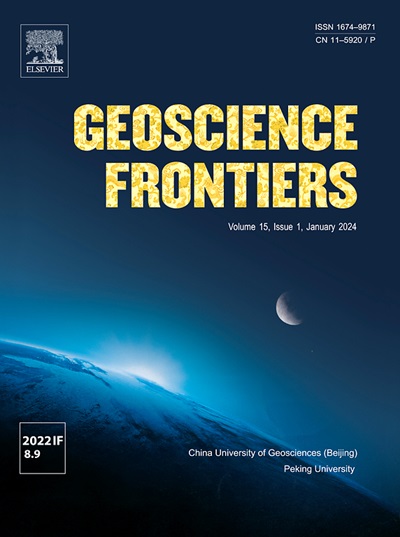全球U-Pb碎屑锆石年龄分布是全球火成岩活动的有效代理吗?
IF 8.9
1区 地球科学
Q1 GEOSCIENCES, MULTIDISCIPLINARY
引用次数: 0
摘要
在解释结果时,必须对结果可复制的程度有一定的了解。如果结果不能用独立的数据来复制,那么对结果的解释就会变得可疑。为了尽量减少误解的可能性,本研究分析了来自全球采样的U-Pb锆石数据库的六个时间序列,其中两个是独立的火成岩数据库,一个是准独立的火成岩数据库,三个是独立的碎屑数据库。然后用标准统计方法对这些时间序列进行分析,以评估可重复性。这些方法包括将原始时间序列转换为平稳序列的带通滤波、学生t检验、蒙特卡罗模拟、光谱分析的周期图、相关研究和相关图。每个测试都旨在确定特定时间序列的可复制性,以及从时间序列中发现的周期性的可复制性。结果表明,至少有三个关键组成部分可用于评估可复制性:(a) U-Pb火成岩和碎屑锆石年龄分布具有高度可复制性;(b)时间序列可复制性随着年龄的增长而逐渐恶化;(c)可复制性具有规模依赖性,低频旋回比高频旋回更具可复制性。从测试中,我们得出结论,四个谐波周期具有高度可复制性和统计学意义,这些周期分别为810、270、90和67.5 myr。本文章由计算机程序翻译,如有差异,请以英文原文为准。

Are global U-Pb detrital zircon age distributions valid proxies for global igneous activity?
When interpreting results, it is imperative to have some understanding of the degree to which the results are replicable. If the results cannot be replicated with independent data, then interpretations from the results become questionable. To minimize the potential for misinterpretations, the current study analyzes six time-series derived from globally sampled U-Pb zircon databases – of which, two are independent igneous databases, one being a quasi-independent igneous database, and three being independent detrital databases. These time-series are then analyzed with standard statistical methods to evaluate replicability. The methods include bandpass filtering to transform the raw time-series into stationary sequences, Student’s t-test, Monte Carlo simulations, periodograms from spectral analysis, correlation studies, and correlograms. Each test is designed to determine the replicability of a specific time-series, as well as the replicability of periodicities found from the time-series. The results show at least three key components to assessing replicability: (a) U-Pb igneous and detrital zircon age distributions are highly replicable, (b) time-series replicability gradually deteriorates with age, and (c) replicability is scale dependent, with low frequency cycles being more replicable than high frequency cycles. From the tests, we conclude that four harmonic cycles are highly replicable and statistically significant, these being periodicities of 810, 270, 90, and 67.5-myr.
求助全文
通过发布文献求助,成功后即可免费获取论文全文。
去求助
来源期刊

Geoscience frontiers
Earth and Planetary Sciences-General Earth and Planetary Sciences
CiteScore
17.80
自引率
3.40%
发文量
147
审稿时长
35 days
期刊介绍:
Geoscience Frontiers (GSF) is the Journal of China University of Geosciences (Beijing) and Peking University. It publishes peer-reviewed research articles and reviews in interdisciplinary fields of Earth and Planetary Sciences. GSF covers various research areas including petrology and geochemistry, lithospheric architecture and mantle dynamics, global tectonics, economic geology and fuel exploration, geophysics, stratigraphy and paleontology, environmental and engineering geology, astrogeology, and the nexus of resources-energy-emissions-climate under Sustainable Development Goals. The journal aims to bridge innovative, provocative, and challenging concepts and models in these fields, providing insights on correlations and evolution.
 求助内容:
求助内容: 应助结果提醒方式:
应助结果提醒方式:


